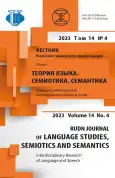Characteristics of Somatic Phraseology in E. Vodolazkin’s Novel “Lavr”: Semantics, Functional Potential, Frequency of Use
- 作者: Karpinskay N.V.1, Shkuran O.V.2,3, Shkuran S.A.4
-
隶属关系:
- Lugansk State Pedagogical University
- RUDN University
- Lugansk State Agrarian University
- IEC Kowloon Bay International kindergarden
- 期: 卷 14, 编号 4 (2023): INTERDISCIPLINARY RESEARCH OF LANGUAGE AND SPEECH
- 页面: 1253-1270
- 栏目: SEMIOTICS. SEMANTICS. PAREMIOLOGY
- URL: https://journal-vniispk.ru/2313-2299/article/view/323629
- DOI: https://doi.org/10.22363/2313-2299-2023-14-4-1253-1270
- EDN: https://elibrary.ru/AWXHMG
- ID: 323629
如何引用文章
全文:
详细
The study selects and analyzes quantitative and qualitative indicators of somatic components retrieved from E.G. Vodolazkin’s novel «Lavr». The illustrative material reveals the universal and national value orientations of the regular and author’s somatic phraseological units. The most frequently used components-somatisms (eyes, head, soul, heart, hand, body) reflect the social and cultural experience of a Russian person and transform them into their own values, attitudes, positions, representing the sacred-mental essence of the nominations of the human body with vivid imagery, stylistic diversity. The analysis of the card file of the used somatic phraseological units demonstrates culturally marked Church Slavonisms that create expressive and emotional images of the Middle Ages and carry evaluative, aesthetic perception in the objective, existential aspects. One of the advantages of the novel is the somaticisms that perform various universal functions in the literary text, both for characterizing the appearance of the characters, the physical and physiological state, and for the conciseness of the narrative speech, for the emotive and emotional state of the main characters. The individual author’s somatic phraseological units detailing the ideological content of the literary text are presented. The analysis allows us present the author’s artistic picture of the world as a part of the linguistic picture of the world of a Russian person. The end-to-end anthropocentricity is a indicative characteristic of the somatic phraseology of the novel «Lavr». The article provides a semantic characteristic and determines the functional potential of more than two hundred and fifty somatic phraseological units used in the novel.
作者简介
Natalia Karpinskay
Lugansk State Pedagogical University
Email: obr_okr2017@mail.ru
SPIN 代码: 2396-9817
head of graduate school 1, territory of LNAU, Artemovsky district, city Lugansky, Lugansk People’s Republic, 1291011, Russian Federation
Oksana Shkuran
RUDN University; Lugansk State Agrarian University
编辑信件的主要联系方式.
Email: oksana.shkuran@mail.ru
ORCID iD: 0000-0002-0063-464X
SPIN 代码: 5495-1079
Scopus 作者 ID: 57223110668
PhD in Philology, Associate Professor of the Department of Russian Linguistics and Communication Technologies, Institute of Philology and Social Communications, Lugansk State Pedagogical University ; Senior Lecturer, Department of Foreign Languages, Medical Institute, RUDN University
2, Oboronnaya, Lugansk, Lugansk People’s Republic, 2291011, Russian Federation;6, Miklouho-Maklaya str., Moscow, Russian Federation, 117198Sofia Shkuran
IEC Kowloon Bay International kindergarden
Email: michaelsofia2014@yandex.ru
teacher of the private educational institution IEC “Marina kindergarten” build. 3, Vanke Jin Yu Zhong Yang, Foshan, Nanhai district, People’s Republic of China
参考
- Teliya, V.N. (1999). Priority tasks and methodological problems of the study of the phraseological composition of language in the context of culture. In: Phraseology in the context of culture. Moscow. pp. 13–23. (In Russ.).
- Shkuran, O.V. (2021). The middle class as a winged unit in the Runet. In: Proceedings of the Vth Firsov readings “Modern languages, communication and migration in the context of globalization”. Moscow: RUDN publ. pp. 542–550. (In Russ.).
- Kipriyanova, A.I. (1999). Functional features of zoomorphisms (based on the phraseology and paremiology of the Russian, English, French and Modern Greek languages). Krasnodar. (In Russ.).
- Shkuran, O.V. & Karpinskaya, N.V. (2021). Cognitive factors of the processes of sacralization and profanization of linguistic semantics of somatic phraseological units with component HEAD. Cognitive Studies of Language, 4(47), 465–472. (In Russ.).
- Gudkov, D.B. & Kovshova, M.V. (2007). The body code of Russian culture: materials for the dictionary. Moscow. (In Russ.).
- Rogozhnikova, T.P. (2013). Characteristics of Use of Church Slavonic Vocabulary in Different Spheres of Communication. Omsk Scientific Bulletin, 5, 135–138. (In Russ.).
- Sklyarevskaya, G.N. (2008). Dictionary of Orthodox Church Culture. Moscow. (In Russ.).
- Slavic Antiquities (2009). Ethnolinguistic dictionary: in 5 vol., N.I. Tolstoy (Ed.). Moscow. (In Russ.).
- Mokienko, V.M., Nikitina, T.G. & Nikolaeva, E.K. (2007). A large dictionary of Russian sayings, V.M. Mokienko (Ed.). Moscow. (In Russ.).
- Sklyarevskaya, G.N. (2014). The heart as an organ of a person’s cognitive and thinking ability: on the question of the semantic structure of the word heart in Holy Scripture. In: Language, consciousness, communication, V.V. Krasnykh, A.I. Izotov (eds.). Is. 50. Moscow: MAX Press. pp. 303–312. (In Russ.).
- Maslova, V.A. (2008). Modern direction in linguistics. Moscow. (In Russ.).
- Uryson, E.V. (1956). Fundamental human abilities and naive “anatomy”. Voprosy Jazykoznanija, 3(1), 3–16. (In Russ.).
- Lomakina, O.V. & Ovchinnikova, G.V. (2021). Phraseological Potential of Somatism Сердце/ Cœur/Herz in the Russian, French and German languages. Vestnik IKBFU. Philology, Pedagogy, And Psychology, 1, 19–28. (In Russ.).
- Popova, Z.D. & Sternin, I.A. (2007). Language and the national picture of the world. Voronezh. (In Russ.).
- Popova, A.R. (2009). Dictionary of one word. Orel. (In Russ.).
- Birikh, A.K., Mokienko, V.M. & Stepanova, L.I. (1998). Dictionary of Russian phraseology: historical and etymological reference. St. Petersburg. (In Russ.).
补充文件









